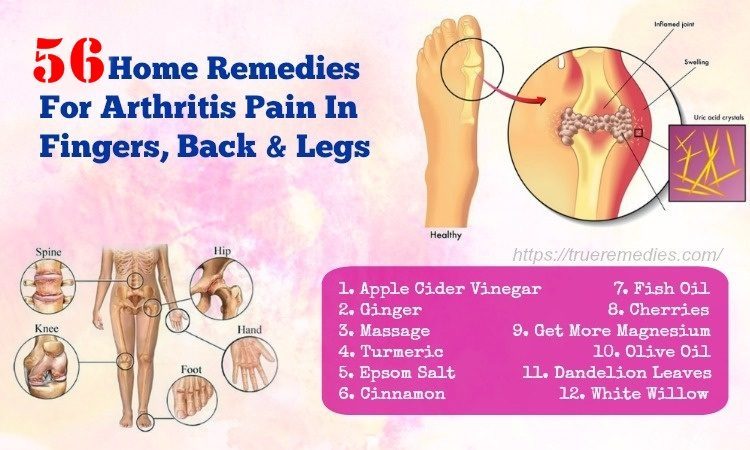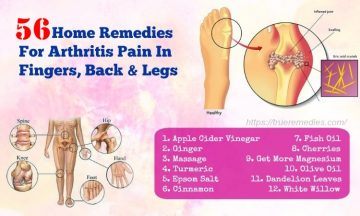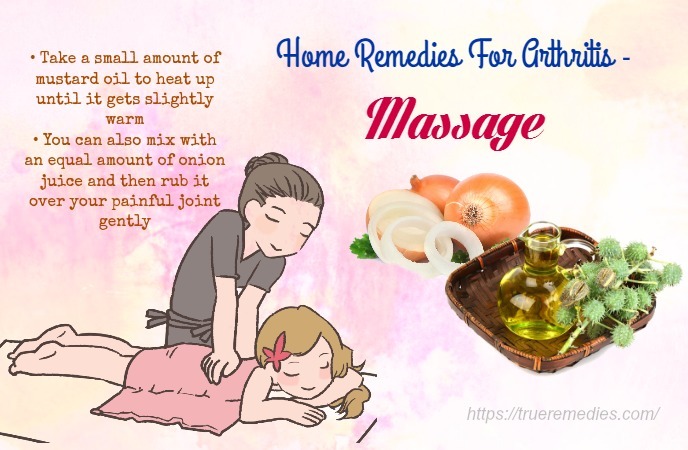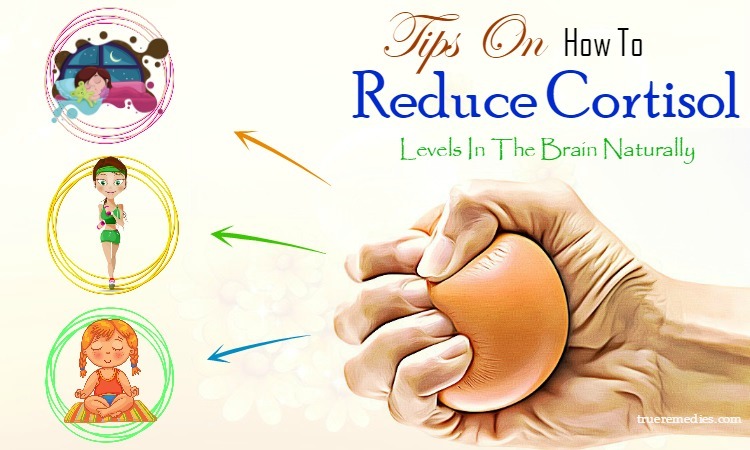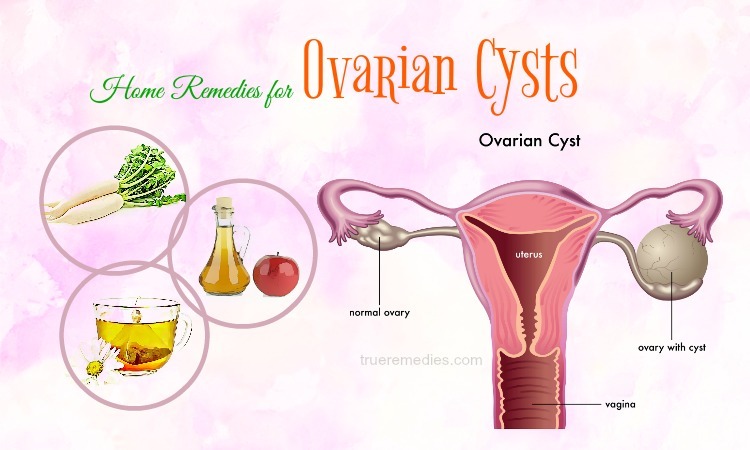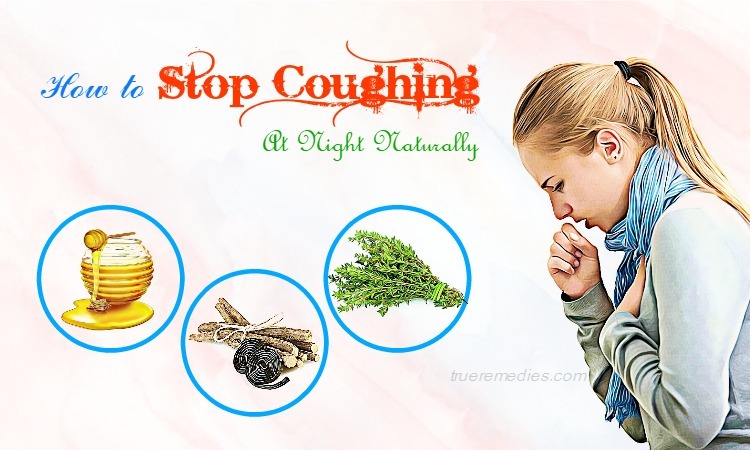updated: 06/14/2019
Contents
Arthritis mentions to rheumatic conditions characterized by aching, pain, stiffness, and swelling both in and around one or more joints. These symptoms could develop suddenly or gradually. Some types of rheumatic conditions could involve the immune system, along with different internal body organs. To understand how to treat arthritis at home naturally, it is important to know what this condition is, what its causes are, and how it is featured. The following article will show you some basics about arthritis, then you can discover top home remedies for arthritis pain in fingers, shoulder, back, and legs. Take a look!
- Top 30 Proven Natural Home Remedies For Joint Pain In Old Age
- Top 29 Natural Home Remedies For Knee Pain Relief
- 10 Natural Home Remedies For TMJ Pain Relief That Work
What Is Arthritis?
Arthritis is an inflammation of the joints, which could impact a single joint or multiple joints. It is estimated that there are over 100 different kinds of arthritis which have different causes and treatments. However, the most common types of arthritis are osteoarthritis and rheumatoid arthritis.
This condition commonly occurs in people over 65, but it may also develop in children, teenagers, and younger adults. In fact, arthritis is more common in women than men, and in people who are obese or overweight. The symptoms of arthritis often develop over time; nonetheless, they sometimes also appear suddenly.
What Are Types Of Arthritis?
It is estimated that there are over 200 types of arthritis, which are divided into 7 major groups:
TrueRemedies Partner Solutions

Need a Help from the Leading Expert Online, Available 24/7?
They’re all here and ready to answer your questions online or by phone. Keep asking questions until you get the answer you need.
- Degenerative or mechanical arthritis
- Inflammatory arthritis
- Back pain
- Infectious (septic) arthritis
- Metabolic arthritis
- Connective tissue disease
- Soft tissue musculoskeletal pain
What Are Causes Of Arthritis?
As mentioned earlier, there are two major types of arthritis that damage our joints in different ways.
Osteoarthritis: This is considered the most common kind of arthritis that involves wear-and-tear damage to the cartilage of your joints. This is the smooth, hard coating on the ends of bones. With enough level of damage, it could cause bone grinding directly on bones, thereby leading to restricted movement and pain. Your risk of developing osteoarthritis is probably higher if you have a family history of this disease.
Rheumatoid arthritis: It is an autoimmune disorder happening when the immune system of your body attacks the body’s tissues. These attacks impact the synovium, soft tissue in the joints that manufacture a fluid nourishing the cartilage while lubricating the joints. The process of rheumatoid arthritis could finally damage cartilage and bone in the joints.
What Are Symptoms Of Arthritis?
Stiffness, joint pain, and swelling are among the common symptoms of arthritis. The range of motion in people with arthritis might decrease, and they might notice redness of the skin around the affected joint. It is reported that the symptoms of arthritis become worst in the morning, according to arthritis patients.
In essence, the inflammation of the affected joints is characterized by swelling, joint stiffness, redness, warmth,and tenderness. Arthritis could impact any joint in the human body, such as hips, knees, fingers, wrists, ankles, back, neck, and feet. The pain associated with arthritis might be constant or intermittent. Even some kinds of arthritis lead to acute episodes that are often called flare-ups.
The inflammation of arthritis might also be associated with some general “flu-like” symptoms such as:
- Chills
- Fever
- Headaches
- Fatigue
- Muscle stiffness
- Energy loss
- Appetite loss
So, what trigger the symptoms of arthritis inflammation? In fact, when the inflammation happens, the chemicals from the body are automatically released into the blood or impacted tissues. The process of chemical releasing will increase the blood flow to the injured or infected areas and might cause warmth and redness. A few chemicals may lead to a leak of fluid into the human tissues, triggering swelling. This process might stimulate your nerves and result in pain.
Who Are At Risk Of Arthritis?
Some risk factors of arthritis are:
- Age: The risk of arthritis will be higher if you get older
- Family history: Some kinds of arthritis develop depending on family history. If your parents or relatives suffer from this disorder, you might be more likely to have this disease. The genes you have could make you much more susceptible to environmental factors that might trigger arthritis.
- Your gender: It is proven that women have a higher chance of arthritis than men. However, most people having gout, another kind of arthritis, are males.
- Obesity: Those who have excess pounds are at higher risk of arthritis because their excess weights put much stress on their joints, especially your spine, knees, and hips.
- Previous joint injury: People with the previous injury of joints, maybe whilst playing a sport, seem more likely to have arthritis or joint pain.
Top 56 Natural Home Remedies For Arthritis Pain In Fingers, Shoulder, Back And Legs
1. Apple Cider Vinegar
For a long period of time, apple cider vinegar has been recognized as one of the most natural remedies for arthritis pain in fingers, back, and legs. This ingredient has antioxidants, acetic acid, beta-carotene, all of which may prevent the cell and tissue damages associated with arthritis[1]. Also, the magnesium content of apple cider vinegar may promote the absorption of calcium, an essential mineral for bone strength.
Furthermore, apple cider vinegar is high in enzymes and acids that may help improve the appropriate digestion and absorb nutrients essential for joints. Arthritis pain is caused by the metabolic waste that is stored in the connective tissues. Fortunately, acetic acid, pectin, and malic acid may help in absorbing the toxins and removing them from your body.
There are some ways you can use apple cider vinegar (ACV) for arthritis. Here are the most effective ways that you can try out at home.
Method 1: Apple cider vinegar & cherry juice
Because cherries are high in anthocyanins, which could combat inflammation, you can combine apple cider vinegar and cherry juice to have a solution for arthritis pain.
- Put 1 teaspoon of apple cider vinegar to a glass of fresh cherry juice
- Have this drink twice per day to relieve symptoms of arthritis pain.
Or, you should also add more cherries and apple cider vinegar to your daily diet to improve your immune system and boost energy levels.
Method 2: Apple cider vinegar & water
- Combine 1-3 teaspoons of ACV and 8 ounces of plain water
- Add honey to it (optional)
- Have this solution thrice per day before meals
This mixture will help relieve your external pain effectively.
Method 3: Soak in apple cider vinegar
- Mix apple cider vinegar and warm water at a ratio of 1:6
- Soak your affected joints in the solution for about 30 minutes
- Do this routine whenever you feel pain.
Method 4: Apple cider vinegar & carrier oils
- Combine apple cider vinegar and coconut/olive oil at a ratio of 2:1
- Massage the mixture on your affected joints for several minutes and let it be there for a few minutes before washing it off
- Repeat this routine regularly to get good results.
Method 5: Make apple cider vinegar tonic
This tonic has antifungal and antibacterial properties, so it plays as an antacid.
- Mix 1 tablespoon of ACV and 1 teaspoon each of cinnamon and honey
- Put the mixture into a 10 oz. glass of the peppermint tea
- Drink this solution every day
Method 6: Have a bath with apple cider vinegar
- Add 1-2 cups of ACV to your hot bath water
- Soak in the solution for 30 minutes and massage your body with this mixture
- Use light strokes without pulling your skin downwards
- Do this routine regularly to get noticeable results.
Method 7: Apple cider vinegar and grape juices
- Mix apple cider vinegar, grape juice, and apple juice at a ratio of 1:5:3
- Have ½ cup of this solution each day
Method 8: Apple cider vinegar poultice
- Mix ½ cup of apple cider vinegar and 1 ½ cups of plain water
- Add the mixture to a pan
- Heat this solution until it is hot but can be touched.
- Soak a washcloth into the solution and wring the excess water out
- Soak your painful joints in the solution and wait for 15 minutes
- Repeat this routine if necessary
Cautions:
- When using apple cider vinegar for arthritis, you should use raw, organic, unfiltered, unpasteurized type for the best results
- Consult your doctor before using this ingredient if you are using any medications
- Apple cider vinegar might lead to or exacerbate the stomach or throat pain
- Drink apple cider vinegar diluted with water via a straw; otherwise, it could affect your tooth enamel negatively
- Some people have allergic reactions to apple cider vinegar
2. Ginger
This is another option in this list of home remedies for arthritis pain. Ginger may be used to decrease joint pain and alleviate inflammation in those with arthritis[2] [3]. It also improves blood circulation in people with Raynaud’s phenomenon.
Ginger has been famous for centuries because of its anti-inflammatory properties, which are useful in relieving pain associated with arthritis[4]. According to a vitro study carried out in 2012, a specialized ginger extract named Eurovita Extract 77 could reduce the inflammation reactions in those with rheumatoid arthritis as efficiently as steroids. It is because of gingerols and shogaols[5], powerful phytonutrients that may fight against inflammation, stop the pain and radiating heat, and prevent cartilage destruction caused by arthritis. Also, ginger has salicylate that is converted into salicylic acid in the human body. This acid may prevent the production of prostaglandins that lead to discomfort and pain.
You can both consume ginger in the whole or powdered form and use ginger capsules and supplements for good results.
Method 1:
- Grind 6 teaspoons of dried ginger, 3 teaspoons of black pepper powder, and 6 teaspoons of caraway seed powder.
- Mix ½ teaspoon of this solution with water and have it 3 times per day.
Method 2: Ginger oil
- Apply ginger oil to your affected area daily to reduce stiffness, pain, and inflammation.
Method 3: Ginger tea
- Cut a pinch of ginger into thin slices
- Add these slices to a cup of boiling water and allow it to steep for 10 minutes
- After that, discard those slices and sip the tea slowly
- Have this method 2-3 times per day
Method 3: Ginger and lemon
Lemon is high in vitamin C that may promote the production of collagen, the main component of the cartilage in the joints.
- Add a 3-cm piece of the ginger piece to a liter of hot water
- Let it steep for 10 minutes and take out the ginger
- Add 1 teaspoon of honey and the same amount of lemon juice to the solution
- Have this tea twice per day
Method 4: Ginger and turmeric
Thanks to the curcumin, active ingredient in turmeric, it may help in treating arthritis by decreasing its symptoms such as inflammation, swelling, stiffness, etc. Turmeric, combined with ginger, deserves one of the best home remedies for arthritis.
- Mix 1 teaspoon each of ginger root and freshly grated turmeric and add them to a glass of tepid water
- Allow it to steep for 5 minutes and add a teaspoon of black pepper to the mixture
- After stirring well, have it 1-2 times per day.
Caution: Black pepper is a must in this treatment as it helps increase the absorption of curcumin in the body.
Method 5: Ginger and garlic
Garlic has anti-inflammatory properties[6] that may inhibit the production of the proinflammatory substances called cytokines.
- Crush 3-4 cloves of fresh garlic and ½ inch of ginger into a good paste
- Consume 1 tablespoon of this mixture with a glass of warm water
- Do this 1-2 times per day
Method 6: Ginger and coconut oil
Coconut oil is good for arthritis pain if taken internally or applied externally. It is because of anti-inflammatory effects[7] that may relieve pain associated with arthritis and lubricate the muscles and joints.
- Heat a cup of water and add 1 tablespoon of grated fresh ginger to it, followed by 1 tablespoon of coconut oil
- Mix them well and drink this solution once or twice per day, in the morning and afternoon.
Method 7: Ginger oil
You can also take advantage of the oil form of ginger for arthritis relief. This oil has chemicals that possess anti-inflammatory and analgesic effects. These properties may help relieve pain significantly.
- Heat 2 tablespoons of olive oil (extra virgin type) for 3 minutes or so
- Then, add 3-4 drops of ginger oil to it and let the mixture cool down
- Massage your affected joints with this mixture for 10 minutes, using gentle and soft strokes to prevent pain and damage.
- Do this routine twice per day
To accelerate the benefits, you could also add ½ teaspoon of turmeric to this solution.
Method 8: Ginger and Epsom salt
Because Epsom salt has magnesium sulfate that could relax the nerve endings and muscles, it may give you relief from arthritis symptoms such as stiffness and pain, when combined with ginger.
- Add a fresh ginger root of about 5 inches to 2 quarts of plain water in a pan
- Boil the mixture for 5-7 minutes
- Let it cool down to a warm temperature
- Afterward, add ½ cup of Epsom salt to the mixture and soak your affected joints to the solution for about 15 minutes
- Repeat the remedy once per day.
Caution:
If you feel it is inconvenient to soak your sore joints in the solution, have a bath with the water added with this mixture.
Method 9: Ginger oil and mustard oil
The next suggestion among natural solutions for arthritis is the mixture of ginger oil and mustard oil. Mustard oil has omega-3 fatty acid, selenium, magnesium, and allyl isothiocyanate that may relieve arthritis inflammation and pain[8].
- Combine 2 drops of ginger oil and 1 tablespoon of warmed mustard oil.
- Massage the mixture on your problematic area to reduce pain and swelling
- Apply this natural method thrice per day.
Caution: You could also add mustard oil to your cooking routine to promote the healing process.
3. Massage
When it comes to remedies for arthritis, massage is recommended the most. There are many techniques of massage you can choose from. Massage gives you a lot of benefits such as relieving the common symptoms of arthritis (stiffness and pain), improving range of motion in joints, easing anxiety, and enhancing sound sleep [9]. According to Tiffany Field, Ph.D., a research psychologist at the University of Miami Medical School, massage could give a significant alleviation in pain[10]. Any kind of full-body massage therapy involving moderate pressure may relieve arthritis pain and tension[11].
If you could do it, or if someone is ready to do it for you, then massage is a great solution for relieving your arthritis pain. Getting a good massage every 1-2 weeks could help you make a noticeable improvement. The release of tension around your sore joints will ease the pressure on your bones and help you relax.
However, moderation is key to properly stimulate the pressure receptors under your skin that convey signals to your brain to lessen pain while releasing beneficial stress-reducing neurochemicals such as serotonin. There are some types of massage techniques you can use, such as Swedish massage, deep tissue massage, hot stone massage, ayurvedic massage, Anma, Thai massage, myofascial release, reflexology, rolfing, etc.
Method 1:
- Take a small amount of mustard oil to heat up until it gets slightly warm
- You can also mix mustard oil and onion juice at a ratio of 1:1 and then rub it on your painful joint gently
- Cover your affected joint with the plastic wrap
- Repeat this routine every day before going to sleep to get good results.
Method 2:
- Mix eucalyptus oil with wintergreen oil.
- Rub the mixture on your joint and massage for a few minutes to get noticeable results
4. Turmeric
If you consume turmeric regularly, it may help reduce inflammation significantly. As mentioned earlier in tip No. 2, thanks to the content of curcumin that has anti-inflammatory effects, turmeric could deal with rheumatoid arthritis effectively[12]. Curcumin is also shown to has antioxidant, anti-cancer, and neuroprotective properties, and it is a key chemical in turmeric that may reduce pain and stiffness related to rheumatoid arthritis and osteoarthritis[13]. This ingredient is traditionally used in Indian Ayurvedic and Chinese medicine to treat arthritis. Because turmeric in the natural form is safe, this supplement should be added to your diet. Actually, there are a variety of ways to introduce turmeric/curcumin to your diet. You can use it as a spice, a tea, or a supplement.
Method 1: As a spice
- Add turmeric powder in smoothies, curries, or salads. Also, add some black pepper to your dishes to boost benefits.
Method 2: As a tea
Buy turmeric tea or make it by yourself.
- Add 1 teaspoon of turmeric powder and ½ teaspoon of black pepper to 2 cups of water
- Boil it up and let it steep for 15 minutes
- Add honey, milk, or honey to taste
- Drink this tea 2-3 times per day to get good results.
Method 3: As a supplement
It is shown that curcumin capsules and supplements are the most effective way to get curcumin. Many supplements also have extra ingredients that may enhance absorption. You should take 500mg of curcumin twice per day.
However, ask your doctor before using any type of supplements.
Caution: Because high doses of turmeric could act as a blood thinner and lead to stomach upset. Thus, you should avoid turmeric/curcumin if you are pregnant, are taking blood thinners, are going to have surgery, and have gallbladder disease.
Turmeric also lowers the blood glucose level. Thus, people who are taking oral anti-diabetes medicines should control their blood glucose level closely to prevent it from dropping too low when taking turmeric.
5. Epsom Salt
One of the most effective home remedies for arthritis is Epsom salt that has antioxidant and anti-inflammatory properties[14]. According to the Mayo Clinic, the use of Epsom salt might decrease stiffness as well as pain because of arthritis[15]. The main component of Epsom salt is magnesium. Using Epsom salt may lessen inflammation, thereby relieving pain and muscle cramps. Nonetheless, before beginning an Epsom salt regime, you should consult your doctor first.
Method 1:
- Mix ½ teaspoon of cinnamon powder with 1 tablespoon of honey
- Add them to a cup of warm water
- Drink it in the morning before having a breakfast
- Do this a few days to get better results
Method 2:
- Combine cinnamon, honey, and Epsom salt to create a good paste
- Massage it on your painful area to get relief from arthritis
Method 3:
- Add 2 cups of Epsom salt to your bathtub of warm water
- Soak in there for 30 minutes
- Do this method 2-3 times per week to get relief from inflammation and pain
This is also an excellent way of getting magnesium that your body requires.
Caution:
If you have some certain health problems like kidney disease or heart disease, excess magnesium, which is taken from using Epsom salt, might result in cramps, nausea, and abnormalities.
6. Cinnamon
Cinnamon is commonly used as a natural treatment for various illnesses and pain, including arthritis pain. Arthritis is an autoimmune disorder which the immune system of our body attacks the joints, causing bone loss, inflammation, swelling, and unbearable pain. Using cinnamon will give relief from pain naturally without any side effects. The chemical combination of this herb makes it a powerful healing agent for arthritis[16]. That is why cinnamon is listed as one of the home remedies for arthritis pain. Cinnamon has a chemical called cinnamaldehyde that helps to reduce the inflammation around joints thanks to its potent anti-inflammatory property. Also, cinnamon may delay the loss of bone from joints while preventing tissue damage at the joints.
Method 1:
- Boil 1 cup of water and add 1 tablespoon of honey and ½ teaspoon of cinnamon to it
- Allow it to steep for several minutes, strain it up, and drink twice per day, one in the morning and one in the evening.
Method 2:
- Add a pinch of cinnamon to rice preparation, curries, salads, and yogurt to get similar effects.
Method 3:
- Make a paste of honey and cinnamon and massage it on your affected area for instant relief.
Caution:
- You should consult a doctor before using cinnamon. There is no specific dosage for cinnamon for medicinal purposes. But do not take more than 11 mg every day.
- Cinnamon spice also has some side effects. If taken in excessive dosage, it may cause ulcers, irritation in the stomach, and fast heart rate.
- Cinnamon could act as a blood thinner, so consult your doctor if you are taking blood-thinning medicines.
7. Fish Oil
Fish oil, one of the safest remedies for arthritis, is the oil coming from cold water fish such as salmon, tuna, herring, halibut, cod, and mackerel. It may decrease inflammation and morning stiffness related to arthritis. Fish oil has a great content of omega-3 fatty acids (DHA and EPA), that may block the inflammatory cytokines and prostaglandins[17]. According to studies, DHA and EPA significantly decreased joint stiffness and tenderness in people with rheumatoid arthritis[18]. Fish oil supplements, when used with olive oil, shows a positive effect on people with arthritis.
So, how much fish oil should you take for arthritis pain relief? According to the FDA, it is safe to take not over 3000 mg of omega-3 each day. To take advantage of fish oil, you consume 1-2 teaspoons of fish oil every day. Or, taking fish oil supplements in the morning before having breakfast may also reduce your morning stiffness.
Add more cold-water fish and other foods that are high in omega-3 fatty acids to your diet to improve your healing process.
8. Alfalfa
Alfalfa means “father of all foods,” and it deserves that name. Thanks to various minerals, such as calcium, magnesium, sulfur, sodium, chlorine, iron, silicon, potassium, vitamin E, C and K, and trace elements, alfalfa may be used for many purposes[19]. It aids in cleansing the blood, improving blood clots, easing morning sickness, relieving all forms of arthritis, etc.
To make use of alfalfa for arthritis, you can add it to herbal teas, food, and tinctures.
Method 1:
- Add ½ -1 teaspoon of alfalfa seeds to one cup of boiling water
- Let it be there for 20 minutes and then strain it up
- Have this drink twice per day for 2-3 weeks to decrease inflammation
Method 2:
- Take alfalfa capsules, which could be found in the market, daily to get similar effects.
9. Cherries
Cherries, one of the home remedies for arthritis pain, may help you keep painful osteoarthritis and gout flares under control[20] [21]. Scientists from Boston University Medical Center found that consuming at least 10 cherries per day could protect people with gout and arthritis from recurrent attacks[22]. The anthocyanins found in purple and red fruits, including cherries, are beneficial for arthritis. Among cherries, tart cherries get the best praises. This red-colored fruit has anti-inflammatory properties and antioxidants thanks to anthocyanins. These properties make tart cherries a natural solution for people with osteoarthritis and decrease the risk of flares in people with gout. This fruit may fight off inflammation for people with arthritis due to the content of potassium and magnesium, which acts as a natural painkiller.
You can consume 8-10 cherries every day. Or, use fresh, frozen, canned cherries that you could find in grocery stores.
Also, drinking cherry syrup also gives you the same effects.
- Boil a few cherries in water for several minutes until it turns into sweet, strong syrup.
- Have this syrup every day for a few months to get good results
10. Borage
Borage, especially borage oil, is one of the little-known but effective remedies for arthritis. Borage is a plant of which the flowers, leaves, and oil are used as medicine. Borage seed oil is commonly used for many skin disorders and rheumatoid arthritis[23]. Borage flower and leaves are used for treating depression, cough, and fever. Borage seed oil is beneficial for relieving arthritis thanks to essential fatty acids that could regulate the immune system of the body and fight off joint inflammation.
It is estimated that borage seed oil has high levels of two types of polyunsaturated omega-6 fatty acid, including gamma-linolenic acid (GLA) and linoleic acid (LA). GLA, as mentioned earlier, is important for maintaining the cell structure and function of joints.
There is no study assessing the safety of borage seed oil in those with arthritis and other related conditions. However, many studies on other GLA-rich oils claim that they are rather safe without serious side effects.
Method 1:
- Massage borage seed oil regularly on your affected area to improve the healing process of swollen and tender joints
Method 2:
- Drink 1 teaspoon of borage seed oil every day to get relief from pain.
But, you should not ingest borage seeds and other parts of this plant for the safety purpose.
Cautions:
- Borage oil is relatively safe in general, but it could be unsafe when it has pyrrolizidine alkaloids. They are harmful chemicals causing health problems in the body.
- Borage oil is unsafe for pregnant and breastfeeding women because it might cause liver disease and cancer in moms and birth defects in babies.
- Borage oil may also increase bruises and bleeding. Therefore, you should be careful when using it if you have bleeding disorders.
11. Get More Magnesium
This tip is very important if you want to treat arthritis once and for all. Magnesium is an essential mineral that the human body cannot make by itself. It is used in more than 300 different biomechanical responses in the human body. Magnesium could relax the muscles and nerve endings, thereby relieving pain and stiffness[24] [25]. Also, it helps our bones to mineralize. According to the American Journal of Clinical Nutrition, people having a diet high in magnesium or taking supplements have higher bone density and stronger bones. You can take magnesium through foods, oil, or supplements.
For supplements, magnesium capsules work best if used with a healthy diet.
For diet, consume magnesium-rich foods, such as dark leafy greens, legumes, and nuts.
For oil, the magnesium oil could be applied topically and absorbed via the skin. You should rub it on the affected joints to relieve pain.
12. Olive Oil
Olive oil has compounds that offer anti-inflammatory properties[26]. It is proven that people with arthritis if taking 4 teaspoons of olive oil per day for about 12 weeks could notice a significant reduction in stiffness and pain. Also, olive oil has omega-3 fatty acids that offer many beneficial effects and may reduce inflammation. If you apply olive oil carefully and gently to your sore joints, you will feel a soothing feeling.
Method 1:
- Crush some pumpkin leaves, either fresh or dried one
- Add the crushed leaves to a container having some tablespoons of extra virgin olive oil and wait for several minutes to let the leaves be soaked
- Mix them well until you get a paste
- Massage this paste on your painful joints and repeat this routine for 7-10 days
- Repeat this method occasionally if you see benefits
Method 2:
- Rub 2-3 tablespoons of extra virgin olive oil on your sore joints twice per day and massage gently.
You can also add olive oil to your cooking routine. But, remember that heating olive oil to high temperatures could kill some beneficial properties. Protect the healthful properties of this oil by keeping it in the dark, cool pantry or cupboard, or fridge. Also, because olive oil is high in calories, so be aware when using it in your diet plan.
13. Dandelion Leaves
Dandelion leaves have powerful anti-inflammatory properties[27]. Leah Hechtman, the author of “Clinical Naturopathic Medicine,” said that dandelion greens might inhibit interleukins and other immune molecules triggering inflammation. Dandelions are also full of organic calcium that is essential for bone health. Incredibly, this plant is high in vitamin A and C that may repair damage tissue naturally. Linoleic included in dandelion is an essential fatty acid that may regulate immune responses and suppress inflammation.
- Boil 3 teaspoons of fresh dandelion leaves (or 1 tsp of the dried form) with a cup of water
- Add honey to sweeten it up (optional)
- Strain the drink and have it twice
Or, you can toss dandelion leaves in a salad or eat them with some extra virgin olive oil take the same benefits.
14. Blackstrap Molasses
Blackstrap molasses are high in potassium, calcium, and magnesium, making it a good solution for those who are looking for effective home remedies for arthritis. It has been cherished as a home treatment for issues related to bone health. The vital constituents included in blackstrap molasses could regulate muscle tension and nerve while strengthening bones[28].
- Take 1 cup of warm water and add 1 tablespoon of blackstrap molasses to it
- Stir them well and drink it once per day
Additionally, having a tablespoon of blackstrap molasses every morning will help you relieve arthritis pain. Most people who follow this treatment report that the pain disappears after about 20 minutes.
Caution:
- Sometimes, using blackstrap molasses could be a laxative effect.
- It contains mostly sugar, which is not so good for your overall health, so you should be careful when using it.
15. White Willow
White willow bark is the bark from the white willow tree. The bark is often used to make medicines. Willow bark has pain-relieving and anti-inflammatory properties that have been recognized through history. The salicin, an active ingredient in willow bark, is similar to aspirin. Thus, it is used for alleviating pain naturally[29]. That is why white willow is a potential treatment for arthritis pain. Patients suffering from rheumatoid arthritis and given white willow bark as a treatment reported a reduction of 15% in pain.
The bark of the white willow tree could be taken in different forms. The most common form is taking it directly. The bark is dried, so you can chew it regularly to reap its benefits in numerous ways. You can add willow bark powder to boiling water, then strain it up and take regularly. This tea could be used as a mouthwash or applied directly to the sore joints.
Also, you can add powdered bark to food items and consume it regularly. There are willow bark extract capsules sold in the market; you can use them after consulting your doctor.
- Boil 1 cup of plain water and let it simmer for a few minutes
- Add 2 teaspoons of chipped or powdered white willow bark and allow it to infuse for 15 minutes.
- After removing from heat, let it steep for 30 minutes
- Add honey and lemon to sweeten the tea
- Have it twice per day to get good results
16. Peppermint And Eucalyptus Oil
Eucalyptus and peppermint do not treat arthritis completely, but they may alleviate the symptoms of arthritis thanks to its pain-relieving and analgesic properties[30]. The cooling sensation of this combination could reduce your discomfort and give a soothing effect that could relieve pain associated with arthritis.
Directions:
- Blend 5 to 10 drops each of peppermint and eucalyptus oil
- Mix them with 1-2 tablespoons of your chosen carrier oil (grapeseed oil or olive oil) to dilute the essential oil.
- Keep the mixture in the dark glass bottle and rub it on your sore joints
17. Juniper Berry Tea
If you are looking for reputed remedies for arthritis pain relief, then juniper berry is your answer. There are a lot of species in the juniper family; some of them have pain-relieving and anti-inflammatory properties. For juniper berry, it is not for everyone’s taste because it is rather bitter. A 2009 research trial released in the “Journal of Ethnopharmacology” discovered that juniper berry does help with arthritis because of a component named terpinen-4-ol[31]. This substance may suppress a kind of white blood cells called monocytes that respond to signs of inflammation. If taken every day, it might reduce uncomfortable inflammation due to the terpene content.
Directions:
- Boil 1 cup of water and put 1 tablespoon of dried juniper berries in a mug
- Then, pour boiling water over them and let it steep for 20 minutes
- Add honey if you like
- Strain it up and drink twice per day
Caution: Avoid drinking juniper berry tea if you are getting pregnant.
18. Golden Raisins And Gin
This is an interesting old home treatment for arthritis. The flavor of gin is derived from juniper berries that have anti-inflammatory properties[32]. At the same time, the golden raisins (just golden type) that require sulfides in the processing period offer them their featured color. In fact, sulfides are available in both glucosamine and chondroitin, which are useful for arthritis[33]. Used for at least 20 years so far, this remedy has been recommended by many people with arthritis.
Directions:
- Prepare 1 cup of golden raisins and ½ cup of gin.
- Then, pour gin into it so that it covers the golden raisins.
- Use a towel to cover and store them in a dark place until the gin has significantly evaporated (approximately 2 weeks)
- Consume 9 raisins every day
It may take a few weeks to see the noticeable results with this treatment.
19. Boswellia Supplements
Aka Frankincense, Boswellia is native to Asia and Africa. This flowering plant has gum resin and the extract that offer anti-inflammatory and pain-relieving properties[34]. It disables white blood cells that cause swelling and helps shrink tissue that has already become painful and inflamed. Boswellia may help lower the inflammation and prevent autoimmune diseases. It is thanks to a compound called terpenes that is a strong anti-inflammatory agent and protects those healthy cells[35]. A study published in the Natural Medicines Comprehensive Database showed that Boswellia extract could reduce swelling, pain, and trouble motion in those with arthritis or osteoarthritis.
It can be taken in the supplement form that you can find in health stores. The price is reasonable in compared with the cost of other supplements.
20. Pectin And Grape Juice
Another solution for arthritis is the combination of grape juice and pectin. In essence, pectin is a water-soluble carbohydrate substance that could be found in the cell walls of plants. It gives the fruit its firmness when it ripens. It is extracted from fruit to use as a setting agent in the jellies and jams. It has been hypothesized that it helps in returning the synovial tissue to the more lubricated and elastic state, resulting in pain-free movements[36]. Although there are not many studies about pectin and connective tissues, many people said that they get relief from arthritis when using it. The juice from grape may help with inflammation. Eating grapes regularly may be beneficial in improving mobility and reducing pain from arthritis[37].
- Mix 1 tablespoon of liquid pectin with about 8 oz. of the grape juice
- Have this drink once or twice per day for 2-3 weeks.
21. Cayenne
Cayenne contains capsaicin, a component that may inhibit Substance P (SP). In fact, Substance P helps transmit pain signals to the human brain through the nervous systems. When the capsaicin interferes with Substance P, it may minimize the alert to discomfort, thereby reducing the pain related to arthritis[38]. You can also use cayenne “capsaicin” ointment, which is used topically for arthritis treatment or make it by yourself at home using cayenne.
Nonetheless, it is just a temporary treatment among remedies for arthritis pain in fingers, back, and legs, and it should be used occasionally when necessary. Researchers at Harvard University announced that they strongly believe that capsaicin could be used to target pain receptors, without impacting nerve cells and causing any side effects[39].
Or, you can find cayenne pepper as the oral capsules, with the normal dosage of 30-120 mg three times per day.
Here are some steps to make homemade cream using cayenne to relieve arthritis pain.
Method 1:
- Mix 3 tablespoons of cayenne powder with 1 cup of grapeseed oil (jojoba oil, olive oil, or almond oil)
- Heat the mixture in a double boiler for 10 minutes over the medium heat
- Add ½ cup of grated beeswax and stir it until it melts completely
- Place the mixture in the fridge for 10 minutes and whisk it together after that
- Chill in the fridge for 10 minutes and whip again prior to putting it into a glass jar with the tight lid. Store it in the fridge. You can use this mixture for more than 1 week.
- Apply the solution to your sore joints to relieve pain.
Method 2:
With this method, the hotter the pepper, the more capsaicin it possesses; thereby, making this cream super strong.
- Mix 4 cups of grapeseed oil/olive oil with 4 tablespoons of Habanero in a double boiler
- Warm up this mixture over the medium heat for 10 minutes
- Melt 1 cup of beeswax in this mixture and stir well until everything gets blended smoothly
- Chill it for 10 minutes in the fridge and whisk up
- Chill for 10 minutes more and whip together and then pour it into a glass container with a tight lid
- Put them in the fridge and apply it to your affected joints as needed.
This mixture may be used for more than 1 week. Stop using it if you feel any irritation.
Caution:
- Don’t use cayenne if you take stomach acid reducers.
- People taking blood thinners or suffering from bleeding disorders should avoid capsaicin
- Avoid using cayenne pepper without consultations of your doctor.
22. Acupuncture
Acupuncture, a form of Chinese medicine, has gained lots of praises due to its effectiveness for many diseases and conditions, including arthritis[40]. Despite there is less evidence of using acupuncture for treating many diseases, many people still recommend using it to relieve pain. Acupuncture aims to correct the imbalances of energy in the human body. Practitioners will use fine stainless-steel needles to stimulate 14 main energy-carrying channels of the body. Using acupuncture will boost the production of endorphins, natural painkillers that that human body makes.
Acupuncture causes fewer side effects as compared to nonsteroidal anti-inflammatory drugs and other arthritis medication. However, acupuncture does not work on everyone. It has many styles and practitioners. You should go for a licensed professional with the right techniques of acupuncture for arthritis. Remember to ask for what type of acupuncture he/she practices.
Caution:
If you are getting pregnant, it is important to discuss with your doctor or therapist because certain acupuncture points should be avoided during pregnancy.
23. Omega-3s
Some clinical trials discovered that consuming 3 grams of fish fats per day could help relieve joint pain, morning stiffness, and swelling related to arthritis and decrease the demand for drugs[41]. In fact, fish oil may cut down the inflammation causing rheumatoid arthritis symptoms[42]. There are two types of omega-3 fatty acids found in the fish oil, which are DHA and EPA. They could reduce inflammation that causes pain and swelling. Even, some studies have proven that the acids may also suppress the immune system of our bodies. All of them make fish oil a great weapon against arthritis.
You can find out omega-3s in cold fish, such as mackerel or salmon, and in dietary supplements derived from algae and fish. However, foods sources only might not enough to supply beneficial effects as modern farming practices have reduced the amount of omega-3s in foods. Vegetarian sources of omega-3s are spinach, kale, Brussels, salad greens flaxseeds, walnuts, and chia seeds.
If you choose fish oil or flaxseed supplements, you should select a brand containing mercury-free fish oils.
Caution:
- Consult your doctor about potential drug interactions.
- Fish oil has a blood-thinning effect, so be aware if you are taking blood-thinning drugs.
24. Exercise
This is another useful tip among remedies for arthritis pain that you could apply at home[43] [44] [45]. The effectiveness of exercise for arthritis is controversial. There are a lot of low-impact activities like jogging, swimming, or walking around your house that may benefit your arthritis condition. Those activities could go a long way to help rehabilitate your own body and improve your health. Besides, lifting weights may give you better muscle supports and less stress on the joints.
25. Heat/Cold Compresses
You could apply heat by using warm compresses, heating pads, heat patches, hot wax, or warm baths. On the other hand, cold therapy could arrive in an ice pack, cold pack, and frozen vegetable packs.
This type of treatment may work for your arthritis pain because the muscle spasms could cause basic constriction of blood flow[46] [47]. Thus, heat works by boosting the blood flow to the sore areas and relaxing the muscles. Cold sensations will move along large nerve fibers, thereby superseding the pain sensations that travel along other smaller fibers. The cold will reduce inflammation and swelling by constricting the blood vessels.
In fact, when it comes to remedies for arthritis pain, the heat seems to work better than cold. You can apply heat 2-3 times per day for 15 minutes at a time to get relief from pain. Or, you could also take advantage of heated paraffin wax baths. It is extremely good for people with rheumatoid arthritis, particularly the hands.
The cold compresses seem to work better for inflammation caused by injuries such as strains, sprains, and pulled ligaments and muscles. You just need to apply cold packs 2-4 times per day for 15 minutes at a time until your swelling and pain disappear.
Caution:
- Do not overdo either cold or heat compresses because it may lead to burns
- Do not apply cold/heat compresses to the bare skin.
26. Meditation
This sounds strange in regard to remedies for arthritis pain. Meditation is the practice of building a deep focus or concentration. It is said that meditation is a range of mind-body-relaxing techniques that help alleviate pain.
Relaxing techniques of meditation will help to reduce stress and then decrease inflammation and pain related to arthritis[48] [49] [50]. Meditation also aids in relaxing the muscles that tense up with pain. Numerous studies have proven that regular meditation practice could reduce the response of the brain to pain. You need to take 4-5 deep breaths and counts to 10 with each inhalation and exhalation. Doing it 4-5 times per day may improve your overall health and outlook naturally.
Also, this tip comes with no side effects. Thus, there is no reason for you to skip trying this tip on remedies for arthritis.
27. Stinging Nettle
Stinging nettles have been used topically and internally to help fight off the inflammation associated with arthritis[51] [52] [53]. The extract of stinging nettles may decrease the inflammation better than the usual nonsteroidal anti-inflammatory drug (NSAID), according to the University of Maryland Medical Center. Nettle is rather common weed which loves to grow in the area with nitrogen soils. An old method of using stinging nettles is to apply the fresh stinging nettle plant to the affected joints. You could also find stinging nettle in the form of supplements in most health food stores.
28. Bee Sting Therapy
If you have arthritis, some research suggests that a surprising alternative treatment for arthritis is bee sting therapy (also known as bee venom therapy)[54] [55]. This remedy has been used for centuries to deal with a wide range of conditions. For instance, it has been extensively researched and used in Korea. Recent days, it is usually delivered through “herbal acupuncture.”
The theory of this method is that the bee venom will firstly be extracted and diluted, and then it is administered to particular locations on the human body. People who used this method reported less morning stiffness, fewer swollen, tender joints than those given a placebo. Despite there are promising results of bee sting therapy for arthritis, more research is still needed to determine the benefits of this method in preventing and treating this condition.
29. Diet Changes
Last but not least, in regard to remedies for arthritis, diet plays an important role in controlling symptoms of arthritis[56]. Your best bet for controlling pain is an anti-inflammatory diet. These tips will help you figure out a healthy diet plan for your arthritis disease. You should avoid these arthritis-triggered foods, including:
- Fried and processed foods
- Foods cooked at high temperatures, such as heated, grilled, pasteurized or fried foods
- Dairy products
- Tobacco and alcohol
- Salt and preservatives
- Corn oil
Instead, you should eat more fruits and vegetables, fish, broccoli, soy, oils, cherries, green tea, citrus, grains, beans, nuts, and garlic. A healthy eating plan could significantly alleviate the painful symptoms of arthritis, especially rheumatoid arthritis[57].
Arthritis is actually a common disease that could not be cured completely, but its symptoms could be lessened by using 56 home remedies for arthritis outlined in this entry. Try these home remedies and see which may help your problem. Remember, see your healthcare professional if you could not find relief. If you have any comment about this topic, do not hesitate to drop your words below this post. We appreciate and will feedback as soon as possible.

